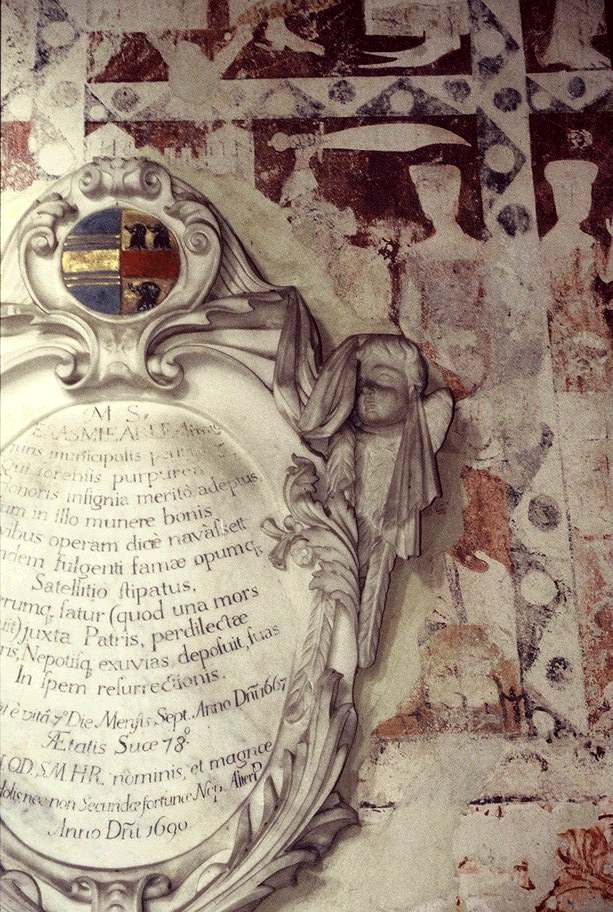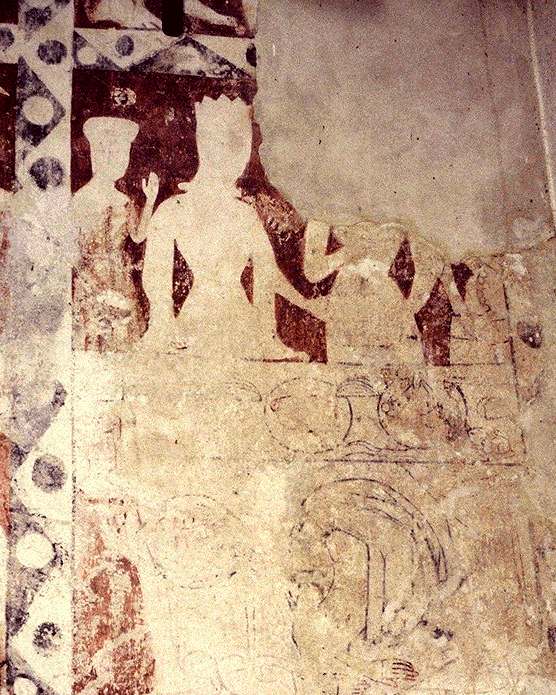Heydon, Norfolk (†Norwich) c1470
The Martyrdom of St John the Baptist
Herod’s Feast, with Salome

This very interesting and very high-quality painting of Herod’s Feast, with Salome performing her dance, has been obscured by the grandiose memorial tablet (in fairness to those who placed it here, the existence of the paintings was almost certainly not suspected at the time). The church was virtually rebuilt about 1470, and most of the paintings now visible were found in 1970, although there are traces of earlier ones, including fragments of an earlier Herod’s Feast/Salome.
The photograph below left shows most of the left-hand side of the subject. The pairs of feet, one with exaggeratedly pointed shoes, are all that is left of figures standing in the topmost tier. Below, just to the right of the memorial tablet, is the executioner’s arm, raised with its great sword to decapitate John the Baptist The female figure at the right might be Herodias, wife of Herod (or more likely, an attendant on her), but apart from some patches of red pigment which probably represented John’s robe, the rest of the saint’s figure has gone.
To the right, and shown here below right, is the incident which resulted in John’s execution. The figure second from the left and wearing a crown, is Herodias. She is flanked by two figures, both apparently female and presumably guests at the party Herod gave for ‘his lords, high captains and chief estates of Galilee’ [Mark 6:21]. Part of another figure is visible at the far right but it is impossible to say whether this is Herod himself or not.
Below the figures, the table is spread. There are three round platters, the one at the left very indistinct. The central platter has the faint outline of a fish, and the one at the right has something on it which might be a boar’s head or similar medieval delicacy. Below, Salome dances in athletic medieval tumbler style, her body bent backwards with head (mostly gone) near the floor and her large hands braced, supporting her. To the left of her, at the edge of the painting, is what looks like a female figure in red with a headdress. She seems to be holding a circular object, and I think this is an attendant with John the Baptist’s head on the platter or charger. This ‘telescoping’ of the dance and its outcome is found elsewhere in scenes of Herod’s Feast – Pickering is another example.

This is not, of course, the kind of dancing to be indulged in by a princess; it was the preserve of the professional dancer, who would in all probability have performed naked. Such people were regarded in much the same light as prostitutes, rogues and vagabonds generally in the Middle Ages, and Salome’s action would have seemed very scandalous. But Pickering in North Yorkshire and Chalfont St Giles in Buckinghamshire also have Salome dancing in this way.
I will try to include the earlier, 14th century version of Salome’s dance here at a future update, although it is very fragmentary. But there are several other paintings at Heydon – The Three Living & The Three Dead, and the Adoration of the Magi are now on the site.